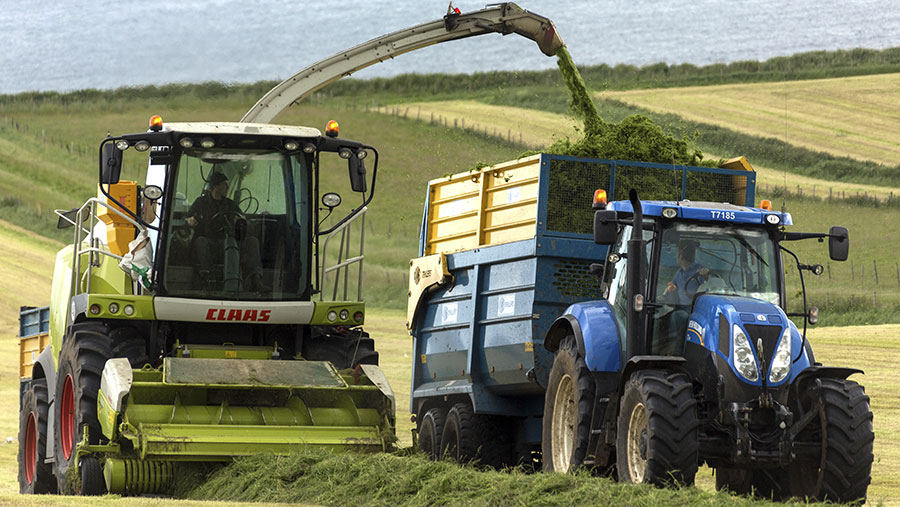How to counter first-cut protein shortfall after cold spring
 © MRallen/Adobe Stock
© MRallen/Adobe Stock Dairy farms that have grass silage with low crude protein levels should consider cost-effective protein sources this winter, after April’s cold nights slowed growth and limited nitrogen uptake.
Farmers that cut early in April and early May generally managed to get a high-energy, but low-protein crop.
Trouw Nutrition’s analysis of 500 first-cut silages concludes:
- There is a huge variation in crude protein (7.47-22.44%)
- Metabolisable energy (ME) varies from 9.24-12.17MJ/kg
- Some neutral detergent fibres (NDF) are very high (29.02-63.13%)
- D-values are variable (58-76%)
- Some dry matters are very low (12.97-54.52%)
- Fermentation quality is mostly good, with moderate pH and lactic acid levels, and mostly low sugars.
See also: Livestock farmers’ guide to taking and analysing silage samples
Trouw advises:
- Start by analysing your forage and look at income over feed cost rather than milk yield
- Optimise the total diets rather than focusing on raw materials or compound feed costs
- If protein is low, farmers must balance the rumen to make the most of microbial protein – the best and cheapest protein source
- Cereal and fermentable proteins and a good bypass protein source should be considered.
Source: Dr Liz Homer, ruminant and technical development manager at Trouw Nutrition GB
Concerning protein levels
Emily Alvis, farm business consultant at Douglas Green Consulting, Wiltshire, says farms with low-protein silages could give rapemeal a look if soya is expensive.
However, she stresses that farmers must be aware of the different amino acid profile and lower bypass protein levels of rape.
“Early-cut silages with low NDFs would need additional structural fibre, especially where fed with maize to ensure good rumen function is maintained.
“Typically, for a 30-litre diet, I would feed 3kg of rape along with energy sources and 2.25kg of soya to achieve a similar result.
“The soya does have increased energy and higher digestible undegradable protein [DUP], but the rape is a more locally sourced, sustainable option to take, so the key is to balance protein sources to get the right DUP and amino acid level.”
Ms Alvis says soya prices were been stable going into the winter, costing £360/t for 29t tipped of a 52% crude-protein product. Rapemeal was cheaper at £225/t for a 42.5 product%.
This means 1kg of protein from extracted rapemeal at 42.5% crude protein would cost about 5.28p/kg, while soya would cost about 6.84p/kg on a dry matter basis.
She says farms that want to maintain milk solids for contract purposes and increase NDF levels in the diet could turn to soya hulls (30.5% NDF) or sugar beet (18% NDF) and present silages well to maintain dry matter intakes.
“To ensure good intakes, rations should be pushed up four to six times a day. Ration presentation and access is also key for palatability and will drive forward cost-effective feeding, production, and cow health.”
“Silage with the correct chop length of 3-4cm will also improve mixing and will help maximise the results from your silage,” says Ms Alvis.
Add urea source
Steve Chapman, director of SC Nutrition, Cornwall, says a protected urea source would suit some systems looking to get protein into the rations and support a functioning rumen with rumen-degradable protein.
Mr Chapman says adding 100g a cow a day of a slow-degrading source of rumen protein, costing 21p a cow a day, would be more cost-effective than soya (if 1kg of soya was 38p). It could be a saving of £30-£40/day across 200 cows or £1,020/month.
He adds: “Even with protected urea being used, there could be a chance to include some feed-grade urea as well, particularly where there is a lot of starch and sugar in the diet to help reduce protein costs even further.”
High fibres
SC Nutrition’s Emma Tristram says some farms that gambled on waiting until May to take a later first cut had been delayed by wet weather and had very fibrous silages.
Comparing a very early crop and a very late crop analysis, she said a 13% difference in NDF (36.6% v 49.6%) means some later first cuts would be hard for cows to digest.
“That 13% difference is an extra 1.8kg of NDF on a cow getting through 14kg of forage dry matter,” explains Ms Tristram. “That is going to slow the cow up, and if you really want to get 15-16kg of forage into a high-yielding cow, you may struggle.”
